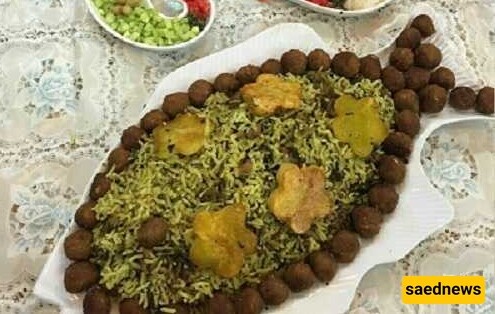Shushtari Pilaf is one of the traditional and delicious Iranian dishes, prepared with various recipes. To see the full cooking guide, continue with Saed News.

Shushtari pilaf with meatballs is one of the delicious and famous southern dishes from the Khuzestan region, known for its unique taste and served as a special dish for gatherings. Follow along with Saed News for the complete step-by-step guide on how to prepare Shushtari pilaf with ground meatballs.

4 cups rice
300g ground meat
1 onion
2 cups fresh dill
1 cup cooked black-eyed peas
1 tsp saffron
Salt, black pepper, turmeric (as needed)
Start by cooking the black-eyed peas. To do this, soak them a few hours in advance and change the water several times to help reduce bloating and speed up cooking. You can also place a cucumber (unpeeled) on top of the peas if you're short on time to soak them. Let the peas cook with a little water.
Grate the onion and squeeze out the juice. Then, mix the grated onion with the ground meat, add salt, black pepper, and turmeric, and massage the mixture well until it becomes cohesive. Form small meatballs and fry them in a pan with some oil.
Wash and dry the dill, then chop it finely. Bring water to a boil in a separate pot, add rice and salt, and let it cook until softened. Near the end of cooking, add the cooked black-eyed peas to the rice. Drain the rice and spread a little oil in the bottom of the pot for the crust. Layer the rice, chopped dill, saffron, and meatballs, and continue until all ingredients are used up.
Cover the pot and let the pilaf steam. At the end, add a bit of butter and saffron on top of the pilaf. Serve with fresh herbs or salad.
You can use dried dill if fresh is unavailable.
Chicken meatballs can also be used as an alternative.
If your meatball mixture is too loose, add some chickpea flour and knead it, or refrigerate it for 30 minutes to firm up.
It’s better to chop the dill by hand, as using a food processor can cause the herb to release water, affecting its color when added to the rice.
Always use strong saffron tea, as the more water you use when brewing, the weaker the color will be, and you will need to use more saffron to achieve the desired color. I always brew saffron using the method taught by Ms. Golavand on a TV show: grind the saffron without sugar or sweeteners. For every teaspoon of saffron, add 2 tablespoons of hot water and two ice cubes. The ice shocks the saffron, releasing more color. Store saffron in an airtight container in the freezer and thaw it at room temperature before using. Make sure the saffron you use is pure; to test, press it between your fingers—if it releases oil, it’s pure. Fake saffron usually has a shiny appearance.

